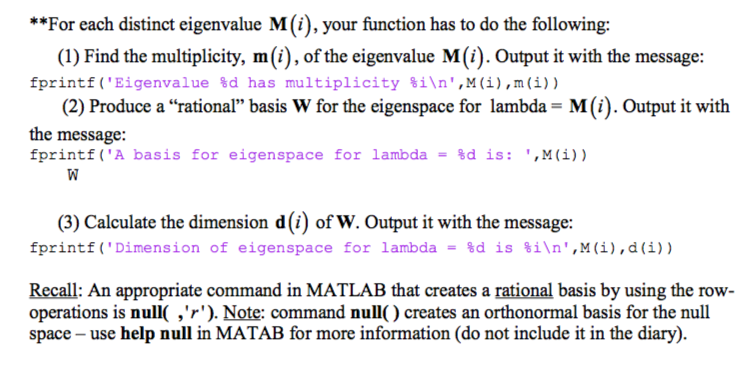Answered step by step
Verified Expert Solution
Question
1 Approved Answer
Computational linear algebra and Matlab. Thank you for the help! Part II. Eigenvectors & Diagonalization Difficulty: Hard Exercise 2 (6 points) In this exercise, you




Computational linear algebra and Matlab. Thank you for the help!
Part II. Eigenvectors & Diagonalization Difficulty: Hard Exercise 2 (6 points) In this exercise, you will, first, find all eigenvalues of a given nxn matrix A. Then you will take each distinct eigenvalue and find a "rational" basis for the corresponding eigenspace and the dimension of that eigenspace. Then, you will decide whether A is diagonalizable by applying the general theory. If the matrix A is diagonalizable, the output has to contain an invertible matrix P and the diagonal matrix D, such that, A PDP, or, equivalently, AP PD **Create a function in MATLAB: function []-eigen(A) Your function eigen(A) should have a set of commands which will generate the following outputs for an nxn matrix A (each output has to be supplied with the corresponding message - you could use the commands disp and fprintf) **Find and output a row vector L of all eigenvalues each eigenvalue repeats as many times as its multiplicity. You should also use closetozeroroundoff function (the code is below) to ensure that a zero eigenvalue will show as a 0 A basic MATLAB command for this part is eig(A) which returns a column vector of all eigenvalues of A and you will use the function transpose to get a row vector. You will also need to sort the entries of L to ensure that your diagonalization will be constructed properly use the MATLAB command sort to output the entries of L in ascending order) **Output a row vector M of all distinct eigenvalues (no repetition is allowed). The MATLAB command unique can be used here (see help unique) Part II. Eigenvectors & Diagonalization Difficulty: Hard Exercise 2 (6 points) In this exercise, you will, first, find all eigenvalues of a given nxn matrix A. Then you will take each distinct eigenvalue and find a "rational" basis for the corresponding eigenspace and the dimension of that eigenspace. Then, you will decide whether A is diagonalizable by applying the general theory. If the matrix A is diagonalizable, the output has to contain an invertible matrix P and the diagonal matrix D, such that, A PDP, or, equivalently, AP PD **Create a function in MATLAB: function []-eigen(A) Your function eigen(A) should have a set of commands which will generate the following outputs for an nxn matrix A (each output has to be supplied with the corresponding message - you could use the commands disp and fprintf) **Find and output a row vector L of all eigenvalues each eigenvalue repeats as many times as its multiplicity. You should also use closetozeroroundoff function (the code is below) to ensure that a zero eigenvalue will show as a 0 A basic MATLAB command for this part is eig(A) which returns a column vector of all eigenvalues of A and you will use the function transpose to get a row vector. You will also need to sort the entries of L to ensure that your diagonalization will be constructed properly use the MATLAB command sort to output the entries of L in ascending order) **Output a row vector M of all distinct eigenvalues (no repetition is allowed). The MATLAB command unique can be used here (see help unique)Step by Step Solution
There are 3 Steps involved in it
Step: 1

Get Instant Access to Expert-Tailored Solutions
See step-by-step solutions with expert insights and AI powered tools for academic success
Step: 2

Step: 3

Ace Your Homework with AI
Get the answers you need in no time with our AI-driven, step-by-step assistance
Get Started


